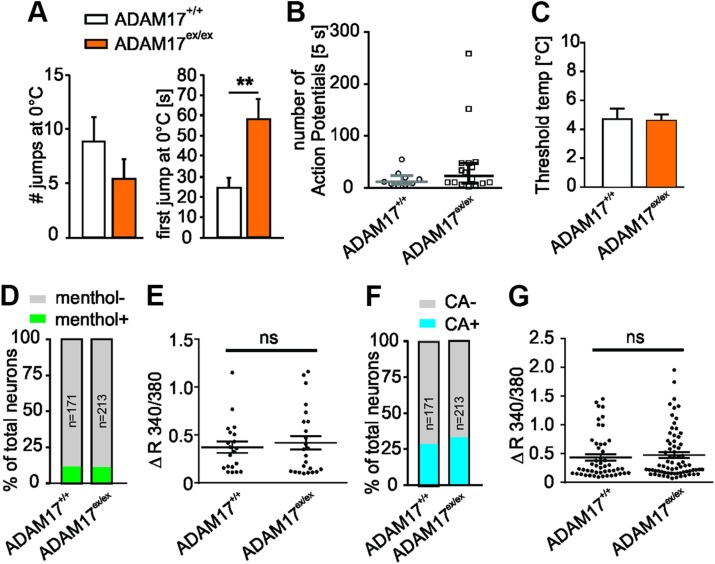Figure 5.
ADAM17ex/ex mice show reduced sensitivity to noxious cold stimuli in vivo. A) Responses to cold within 3 min recordings were reduced in ADAM17ex/ex mice, which showed significantly higher time span to execute the first jump after 0°C stimuli (58.22 ± 9.91 vs. 24.32 ± 5.08 s; ADAM17+/+ n = 14, ADAM17ex/ex n = 13; P = 0.006, Mann-Whitney U test). B) Depletion of ADAM17 did not affect the rate of discharge of cold-sensitive C-fiber afferents to cold stimuli (median: 12.00 vs. 23.50 APs (first 5 s); ADAM17+/+ n = 9, ADAM17ex/ex n = 16; P = 0.3074, Mann-Whitney U test). C) Threshold cold temperatures of cold-sensitive C-fiber afferents was comparable between the 2 genotypes (4.76 ± 0.67 vs. 4.64 ± 0.40°C; ADAM17+/+ n = 9, ADAM17ex/ex n = 16; P = 0.8730, unpaired Student’s t test). D, F) Stacked histograms showing that the proportion of menthol-responding (menthol+) and non–menthol-responding (menthol−) neurons (D) and CA-responding (CA+) and non–CA-responding (CA−) neurons (F) was comparable between control and ADAM17ex/ex neurons (Fisher’s exact test, n = 171–213, P > 0.05). E, G) The dot-plot graph showing no significant difference in both menthol-evoked Ca2+ increase magnitude [(E), Mann-Whitney U test, n = 20–24, P = 0.8795)] and CA-evoked Ca2+ increase magnitude [(G), Mann-Whitney U test, n = 49–71, P = 0.5846)] between genotypes. Results are shown as means ± sem; ns, not significant. **P < 0.01.

